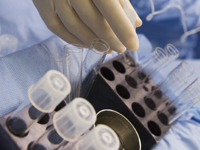Egg vitrification
 What is egg vitrification?
What is egg vitrification?
Vitrification is currently the most effective technique in egg preservation. It is an ultrafast freezing technique in which the cooling rate is so high that liquid water inside the cell transforms into a vitreous state rather than becoming ice (as in slow freezing).
The process of obtaining eggs for vitrification is the same as for an In Vitro Fertilisation cycle.
Stages for obtaining eggs:
1 - Stimulation of ovulation
In the first stage, the woman takes hormones to simulate her ovaries to produce mature eggs. This stage lasts around 15 days.
The hormone treatment has no significant side effects. Even so, some patients experience fluid retention and/or slight abdominal discomfort and stimulating ovulation does carry the risk of ovarian hyperstimulation syndrome, which can be serious.
2 - Ultrasound-guided ovarian puncture
Once the eggs reach maturity in the ovaries, they are extracted to be fertilised in the laboratory. This is performed by ultrasound-guided follicular puncture.
The follicular puncture takes about 20 minutes. After the procedure, the patient needs to stay a while to recover from the anaesthetic, after which she can go home with the advice to rest for the day. Mature eggs are vitrified in the laboratory.
When is egg vitrification advisable?
Egg vitrification is mainly advisable in:
- Women who need to have medical treatments that can affect ovarian function
- Young cancer patients who are about to have chemotherapy and/or radiotherapy
- Younger patients who are going to have surgery that involves significant loss of ovarian tissue, in severe endometriosis for example
- Women who want to postpone maternity
- Couples who, for ethical reasons, do not want to freeze their embryos
- IVF cycles with low ovarian response, in order to accumulate eggs
- IVF cycles in which, on the day of egg retrieval, the male is unable to provide the semen sample to fertilise his partner's eggs
Can all women benefit from egg vitrification?
Most women can benefit from vitrification but the following need to be taken into account:
- In women over 38, success rates are lower due to the reduction in the quality and quantity of eggs with age
- In prepubescent girls who have not started ovulating, vitrification is not indicated because they do not produce eggs valid for this process
What are the benefits of egg vitrification for women who have had cancer?
Treatment for cancer results in decreased ovarian function and, in many cases, complete infertility. The ovary can age between 5 and 10 years and the quantity and quality of eggs is therefore reduced. Depending on their age and ovarian reserve, most patients have to resort to more or less complex assisted reproduction techniques (insemination, In Vitro Fertilisation, egg donation).
In this situation, vitrification proves to be extremely useful and beneficial prior to cancer treatment. The eggs can be preserved under the best conditions and be used in the future to try for the desired pregnancy.
Is this the best technique for preserving female fertility?
Besides vitrification, there are other treatments to preserve fertility: freezing of ovarian tissue, ovarian transposition, protection of the ovaries with GnRH agonists and in vitro maturation of eggs.
How long can my eggs be vitrified for?
The vitrified eggs, like embryos or other tissue, may remain frozen as long as the patient needs them because, technically, the eggs do not deteriorate over time and there are no legal limits.





















